Use these nine chair yoga for beginners moves to boost your mobility and build core strength
This short chair yoga routine is perfect for beginners or when you want an accessible way to practice
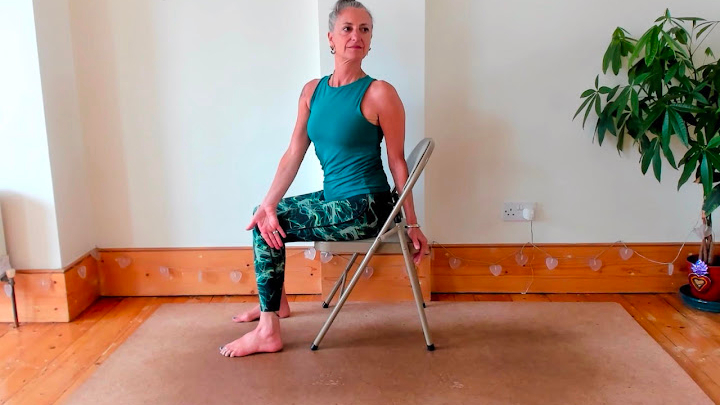

Chair yoga for beginners is where the power of gentle movements and deep breathing combine to create an accessible practice that you can do whether you have injuries, sore joints, or want to boost your mobility.
Perhaps you’ve already tried forms of yoga more typically performed on one of the best yoga mats. However, chair yoga is a modified form that adapts various postures and breathing techniques to be performed while sitting on a chair or using it for support.
This gentle practice provides a multitude of benefits, including improved flexibility, enhanced strength, reduced stress and increased mindfulness. If you've considered doing yoga stretches for beginners but want to build up to those mat-based poses, then this short chair yoga for beginners routine is a great place to start.

Dina Cohen is an experienced yoga teacher with over 20 years of experience. She has worked with dancers from the Royal Ballet, refugees and asylum seekers, and seniors practicing chair yoga in care homes, among others. She offers yoga retreats and holidays, and gives open-to-all regular yoga and chair yoga classes online and in person.
Nine-move chair yoga for beginners
Whether you're after an accessible introduction to the practice or working in a way that feels good for your body, we asked Dina Cohen, an experienced yoga teacher, to design a nine-move chair yoga for beginners routine you can do anywhere.
Her routine combines simplicity, safety and effectiveness, allowing you to move your body, develop a sense of mindfulness, and improve your mobility with a single chair and no other equipment.
1. Gentle neck stretch
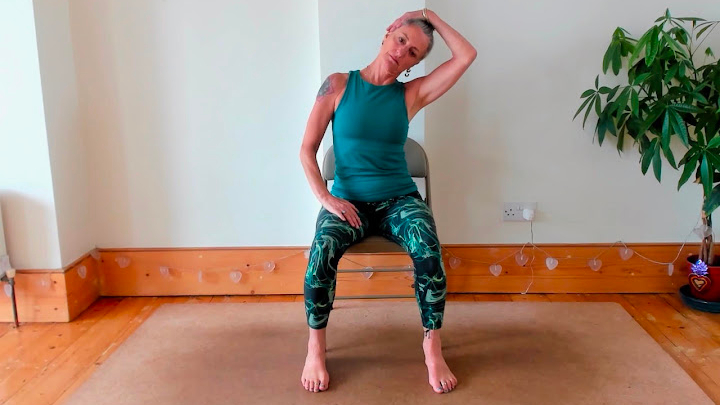
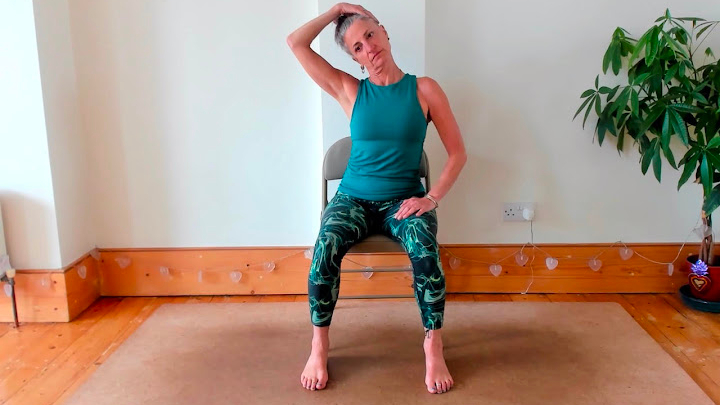
Many of us spend a lot of time on our computers and can find ourselves getting 'tech neck.' This move will help to ease out any tightness or stiffness in the sides of the neck.
- Sit upright in your chair with your feet parallel and hip-width apart. Allow your shoulders to drop down away from your ears.
- Slowly tilt your head towards your right shoulder, then lift it up and tilt it to the left. Repeat a few times, feeling the weight of the head sinking from side to side.
- After a few repeats, tilt to the right and stay here, raising your right arm and bringing your hand to rest on the left side of your head, adding a little weight to the stretch. Repeat on the other side.
2. Chair cat-cow
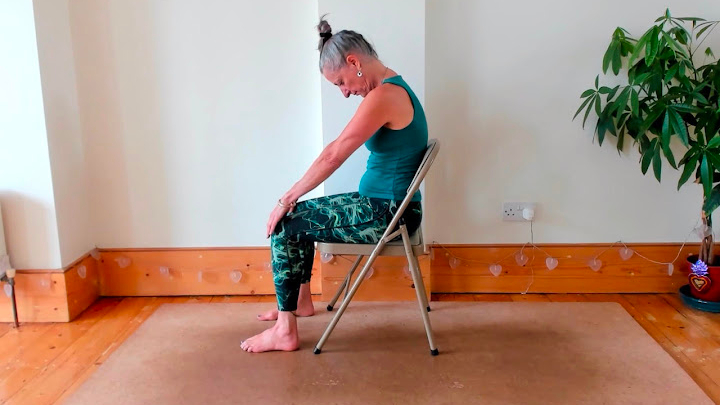
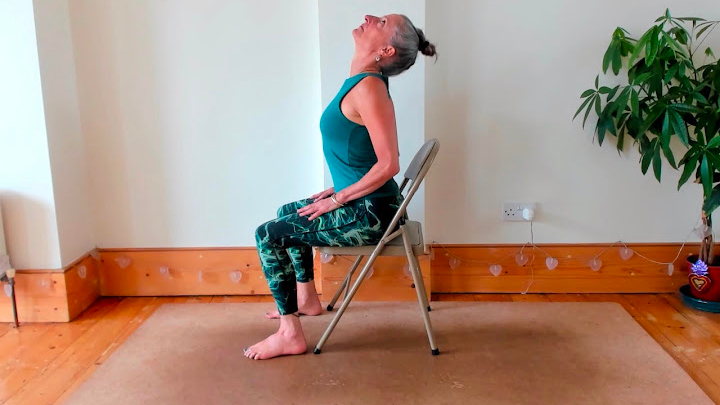
This is a chair version of the cat-cow movements that can also be done on the floor on all fours in the tabletop position. It’s great for mobilizing the spine, shoulders, and neck, while opening the chest and gently stimulating the abdominal organs.
Get the Fit&Well Newsletter
Start your week with achievable workout ideas, health tips and wellbeing advice in your inbox.
- Sitting in your chair, feet parallel and hip-width apart, rest your hands on your knees. Maintain ease in your breathing while allowing each breath to become a little longer, fuller, and deeper. As you take the next exhale, round your spine, bringing your chin towards your chest and stretching your palms over your knees.
- As you inhale, slide your palms halfway up your thighs, lifting your chest and raising your head, bringing your shoulder blades and elbows in towards each other behind you. And then, as you exhale, slide your palms forward again, and round your spine.
- Repeat a few rounds, moving to the rhythm of your breath, feeling how the breath enhances the movement, and the movement enhances the breath.
3. Spinal twist
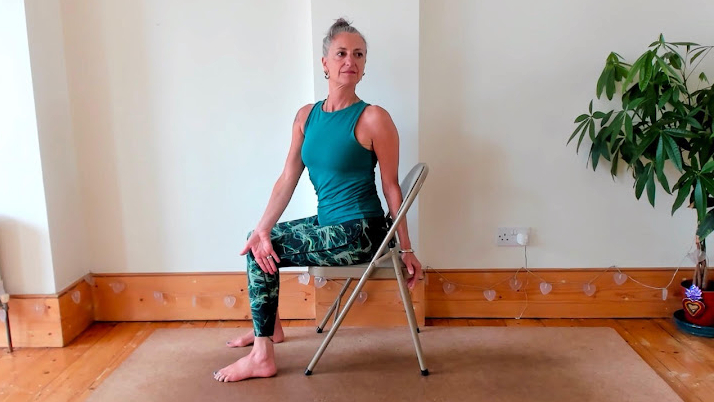
Twists are great for strengthening and lengthening the muscles that support the spine, helping to release tension and ease back pain, increasing circulation, and aiding digestion.
- With your feet hip-width apart and parallel, slide your sitting bones slightly forward on the seat. Lift your ribcage away from your hips, so the spine is long and lifting. Place the back of your left hand on the outside of your right knee, and place your right hand behind you on the back of the seat.
- On each inhale, feel your ribcage and chest expanding as you continue to lift upwards through the spine. On each exhale, moving from the waist, continue to turn your chest a little further to the right, while keeping your shoulders dropping away from your ears.
- After a few breaths, release and turn to the other side, placing your right hand on the outside of your left knee and repeat for a few more breaths.
4. Side stretch
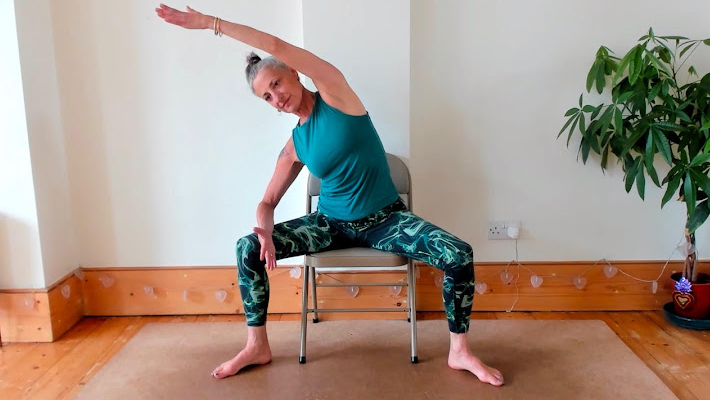
Side stretches lengthen and open the side body, including the sides of the ribcage, enhancing function of the cardiac, respiratory, digestive, lymphatic, and endocrine systems.
- Sit with your feet and knees wide apart, and your toes turning slightly outwards. Try to keep your ankles under your knees. Lean to your right, resting your right forearm halfway along your right thigh.
- While pressing the left foot into the floor, reach your left arm up towards your left ear and continue to stretch it over your head to the right. Be sure to keep your head away from your right shoulder so there is space between the shoulder and the ear.
5. High lunge
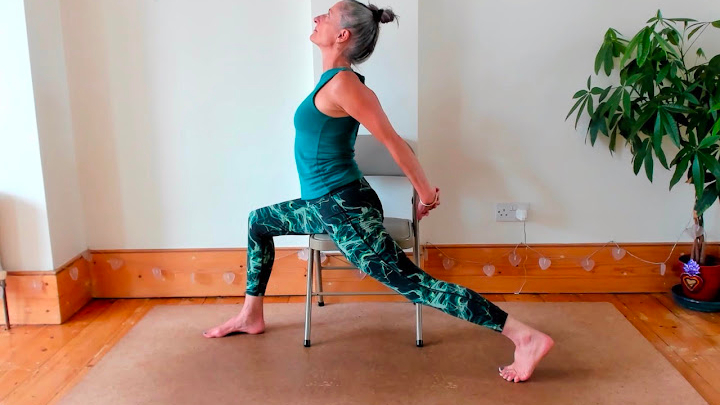
This supported lunge is great if you’ve been sitting in a chair for too long. It helps to stretch out the hip flexors and quad muscles and open the chest. It can improve balance and stability while strengthening joint function of the knees, hips, and shoulders.
- Begin seated in the chair with your feet and knees wide apart. Lift the heel of your left foot and swivel on the ball of the foot, turning the knee inwards towards the right leg.
- Continue to press your right foot down into the floor whilst extending through your left leg and out through the heel. Interlace your fingers behind your back and lift your arms away from your hips, opening the chest. Take a few breaths here before repeating on the other side.
6. Balancing warrior
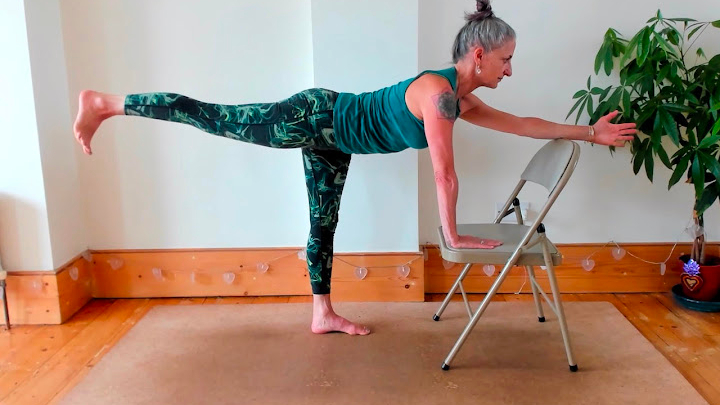
This supported balancing pose develops stability and strength throughout the body, working your ankles, legs, and the core muscles around the abdominals and back. Improving balance is important in preventing injuries from falls.
- With feet hip-width apart, stand facing the seat of the chair. Place both hands on the seat so that your wrists are directly under your shoulder, and your feet are directly under your hips. Your spine should be flat like a tabletop.
- Press both palms into the seat, spreading your fingers wide. Press your left foot into the floor spreading the toes wide. Raise your right leg up behind you. If you feel stable, you could also stretch your left arm forwards over the backrest.
- Reach back with your right heel while stretching forward with your left arm, creating a long straight line between them. Hold for a few breaths before changing sides.
7. Downward-facing dog
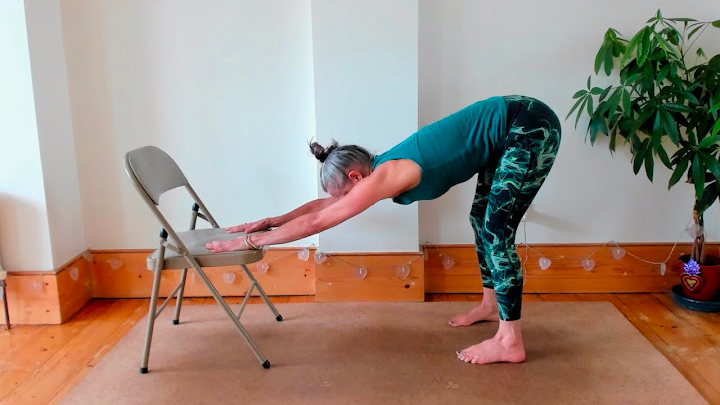
This classic yoga pose can be practiced with the support of the chair, making it more accessible if you have vulnerable wrists and shoulders or tight hamstrings. It elongates the spine, strengthening muscles in the arms, upper-back, and shoulders and gives the hamstrings and calves a stretch.
- Facing the seat of the chair, place both hands on the seat, as wide apart as possible, spreading your fingers out. Keep your hands firmly gripping the chair, walk your feet back until you are stretching forward with your arms. Drawing your hips away from your shoulders and lengthen your spine.
- Keep your feet as wide as your hips and your knees soft. You may like to bend one knee and then the other, stretching through the back of the straighter leg. Hold for a few breaths before walking forwards to release.
8. The Thinker
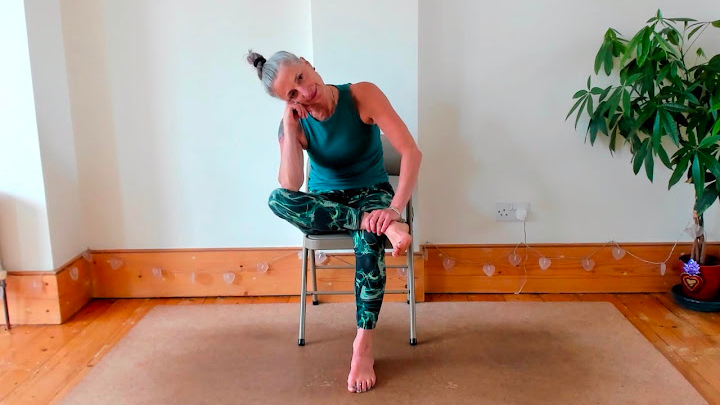
This might look like someone just hanging out having a think, but it’s a great hip opener. If you have trouble getting your foot onto your knee, then you can place it over the ankle of that leg instead.
- Sitting in the chair with your feet hip-width apart, bring your right knee up towards you and take hold of your right foot with your left hand. Place your right ankle just above your left knee and allow the right knee to drop out to the side.
- Rest your right elbow on your inner right knee, and lean your head into your right hand. The more weight you lean into the right arm, the more you will feel the stretch in the hip. If you feel it in the knee you should back off.
9. Feet up
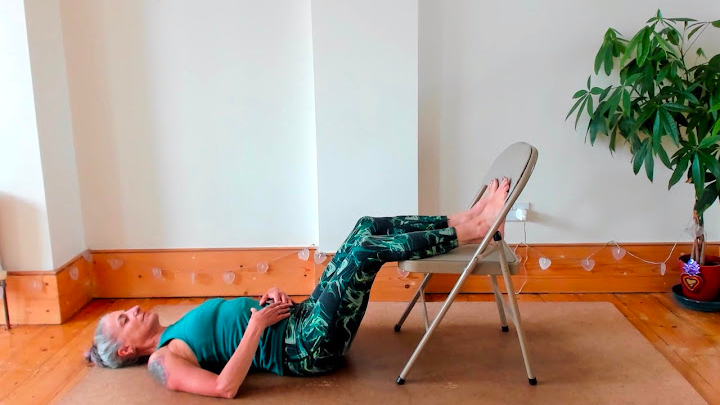
A relaxing alternative to the more complex inversions of mat-based yoga practices. This supported inversion is calming for the mind and the nervous system. It can also reduce inflammation or swelling in the feet and legs.
- Rest on your back on the floor and place your legs over the seat of the chair (or you could use a sofa, a bed, or some cushions). Allow your hands to rest on your belly or down by your sides, close your eyes, and feel your body releasing and softening into the floor and the chair.
- Stay here for up to five minutes. When you are ready to come out, bring your knees towards your chest and roll to one side.
Does chair yoga really work?
If you want to get all of the benefits of yoga, this chair yoga for beginners routine is a great place to start. According to a study published in the Journal of the American Geriatrics Society, researchers at Florida Atlantic University examined the effects of chair yoga on pain and physical function in older adults with osteoarthritis.
The study revealed that regular chair yoga sessions led to significant improvements in pain reduction and physical function compared with the control group. These findings indicate that chair yoga assists in improving the wellbeing and quality of life for older adults with osteoarthritis.
Moreover, the practice is accessible as it removes the need to transition between the floor and standing positions. Through regular practice, it can help you improve your flexibility, strengthen your muscles, relieve stress, and boost your energy levels.
As with all movement, you can also do it to exercise for happiness. Physical activity of all kinds helps reduce stress, develop the mind-muscle connection, and improve your overall health and mobility through the years.
Jessica is an experienced fitness writer with a passion for running. Her career in journalism began in local news and she holds a Masters in journalism. Jessica has previously written for Runners World, penning news and features on fitness, sportswear and nutrition.
When she isn't writing up news and features for Fit&Well covering topics ranging from muscle building, to yoga, to female health and so on, she will be outdoors somewhere, testing out the latest fitness equipment and accessories to help others find top products for their own fitness journeys. Her testing pairs up nicely with her love for running. She recently branched out to running 10Ks and is trying to improve her time before moving on to larger races. Jessica also enjoys building on her strength in the gym and is a believer in health and wellness beginning in the kitchen. She shares all of this on her running Instagram account @jessrunshere which she uses for accountability and for connecting with like-minded fitness lovers.
-
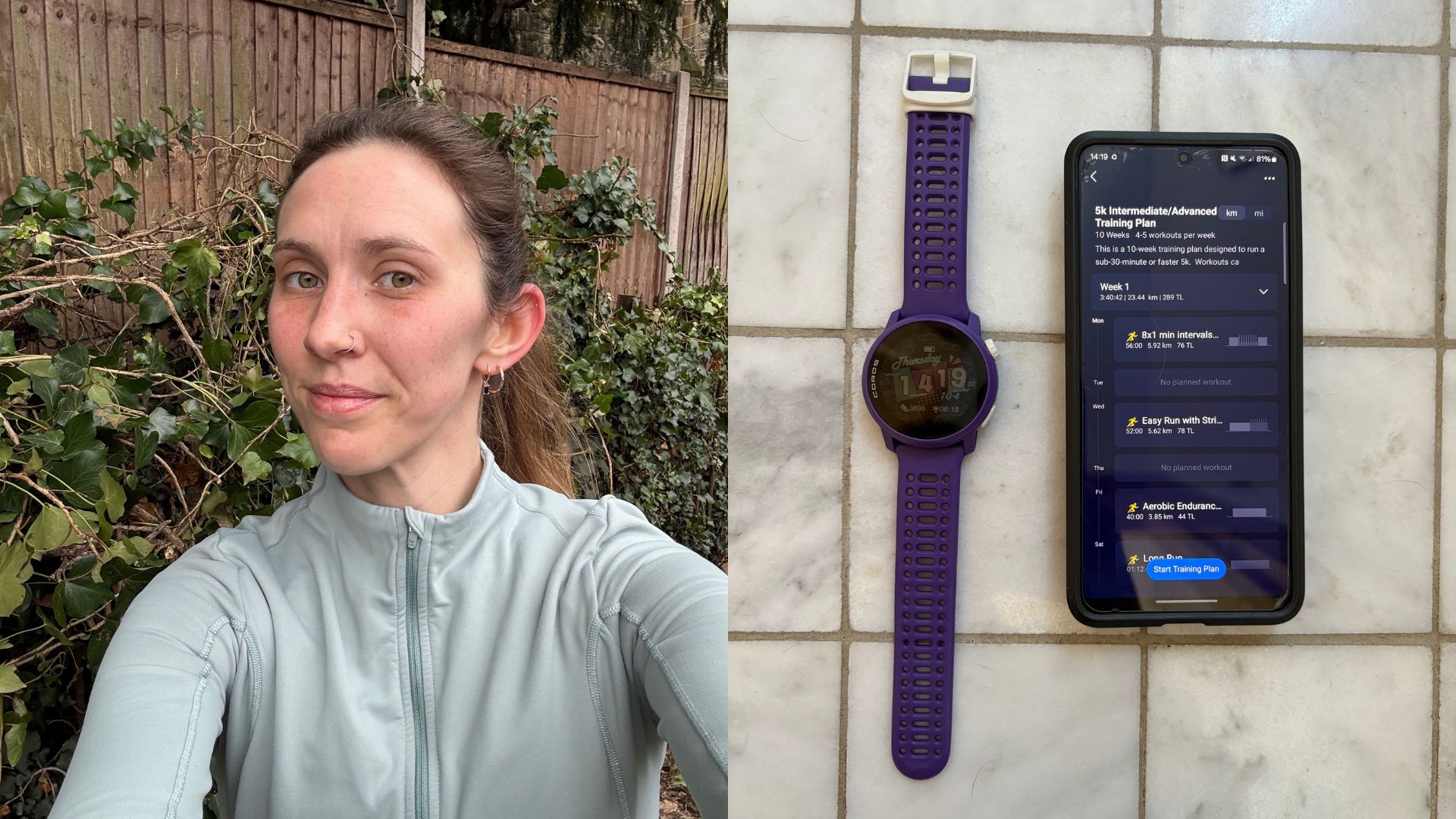 This is the exact running plan I followed for two months to finally get my 5K run time under 30 minutes
This is the exact running plan I followed for two months to finally get my 5K run time under 30 minutesAnd it helped me fall in love with running again
By Ruth Gaukrodger Published
-
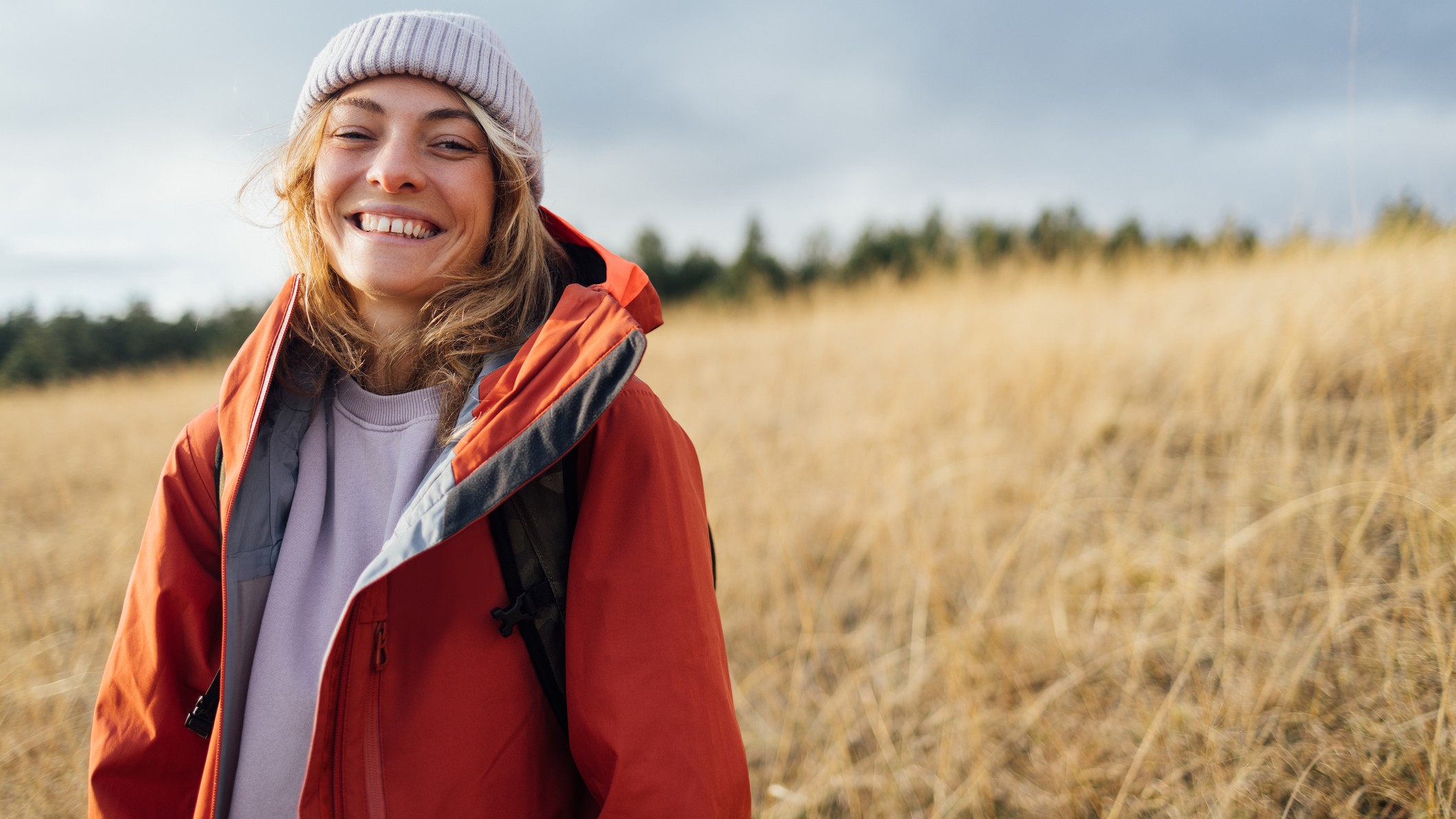 I increased my step count back to 10,000 a day after time off—here’s how I did it sustainably
I increased my step count back to 10,000 a day after time off—here’s how I did it sustainablyIt took me five weeks to get back to the ideal range
By Lou Mudge Published